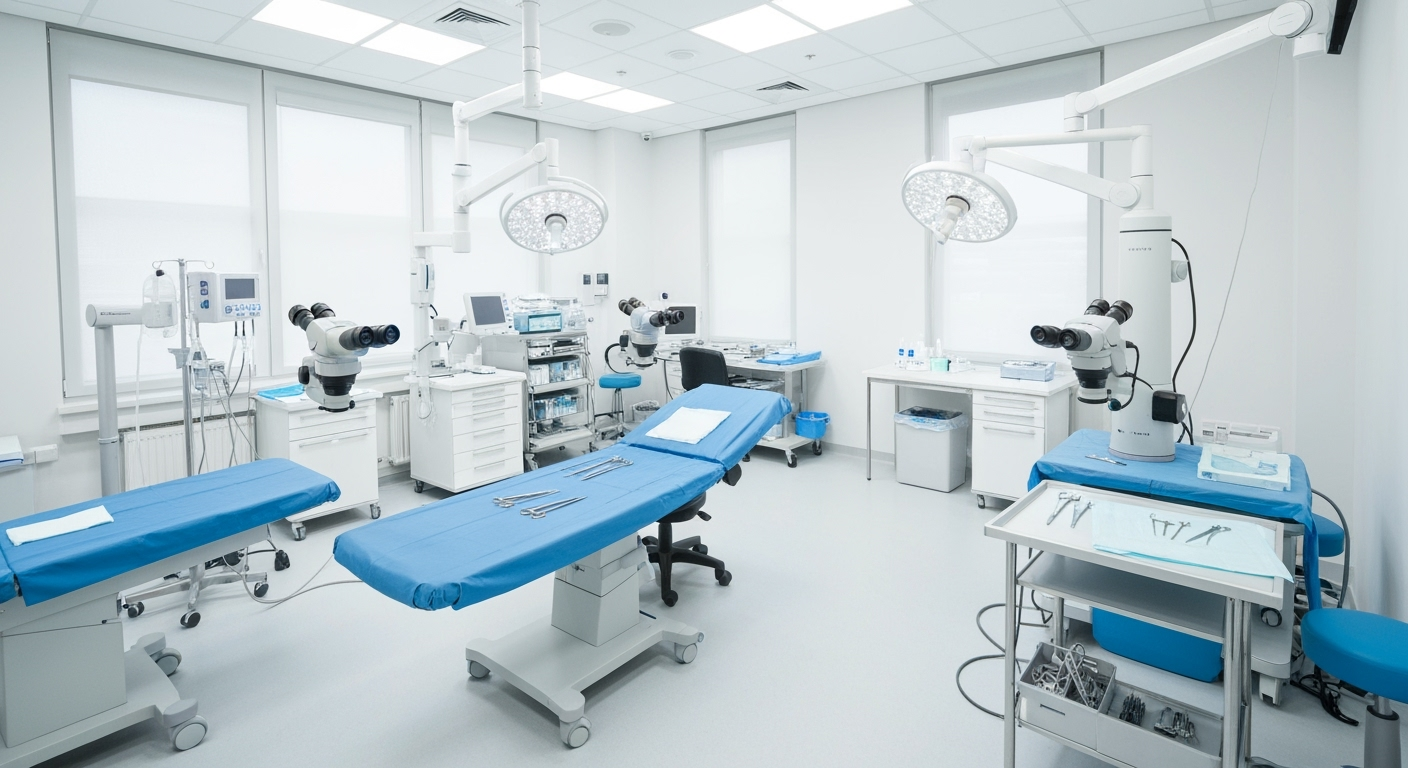Recognizing the Right Time to Address Female Infertility: Key Indicators and Expert Care in Queens

Introduction to OB/GYN Surgical Approaches
As gynecologic surgery continues to evolve, the debate between laparoscopic (minimally invasive) and open surgical techniques remains central to optimizing patient outcomes. This article delves into comprehensive statistical comparisons of these methods, revealing differences in clinical efficacy, safety profiles, recovery, and cost-effectiveness. By examining specific gynecologic conditions such as hysterectomy and endometrial cancer, readers will gain an informed perspective on the benefits and limitations of laparoscopic versus open procedures within OB/GYN surgery.
Key Facts on Laparoscopic vs. Open Gynecological Surgery
- Minimally invasive laparoscopy results in less blood loss, shorter hospital stays, and faster recovery compared to open surgery.
- In endometrial cancer, laparoscopy offers comparable oncologic safety and similar survival rates, with benefits like reduced intraoperative blood loss.
- Laparoscopic procedures retrieve similar lymph node counts during staging, indicating adequate oncologic assessment.
- Obese patients benefit significantly from laparoscopy, which reduces wound infections and facilitates quicker recovery despite technical challenges.
- Compared to open surgery, laparoscopy exhibits lower complication rates, including fewer wound infections and less postoperative pain.
- The adoption of laparoscopic surgery has steadily increased, often surpassing open surgery, thanks to its advantages and technological improvements.
- Laparoscopic skill requires specialized training in instrument handling, spatial awareness, and decision-making, often enhanced through simulation.
- While initial costs of laparoscopy are higher due to equipment, long-term savings come from reduced hospital stays and fewer complications.
- Laparoscopy is associated with less postoperative pain, smaller scars, and earlier return to normal activities, improving patient satisfaction.
- Advanced techniques like robotic-assisted laparoscopy improve safety and precision, making complex surgeries more manageable with better visualization.
1. Laparoscopic vs. Open Surgery for Endometrial Cancer: Clinical Outcomes and Recovery

What are the comparative outcomes and efficacy between laparoscopic and open surgeries for gynecological conditions like hysterectomy, fibroids, and endometrial cancer?
Over the past two decades, minimally invasive surgery (MIS), especially laparoscopy, has increasingly become the preferred option for many gynecologic procedures. Its adoption is supported by a broad range of positive clinical outcomes. Compared to traditional open surgery, laparoscopic approaches typically result in less blood loss, shorter hospital stays, reduced postoperative pain, and quicker returns to daily activities.
Specifically, in procedures such as hysterectomy, the shift towards MIS has reduced the necessity of large abdominal incisions, which are associated with longer recovery times and more tissue trauma. For benign conditions like fibroids or ovarian cysts, laparoscopic techniques often negate the need for extensive open approaches.
However, when it comes to malignant conditions, like endometrial cancer, the decision is more nuanced. While laparoscopy offers comparable oncologic safety in early-stage cases, some studies have reported similar survival and recurrence rates when surgeries are performed properly—both minimally invasive and open approaches provide effective staging and removal of cancer tissue.
In a pivotal study comparing laparoscopic and open surgical staging for endometrial cancer, various operative and postoperative metrics were scrutinized. The results showed that although laparoscopic surgery had longer operation times—averaging around 227 minutes compared to 208 minutes for open surgery—it was associated with significantly lower intraoperative blood loss, with estimates of 230.3 mL versus 301.9 mL in open procedures.
Postoperative benefits of laparoscopy were also evident. Patients undergoing laparoscopic procedures experienced notably shorter hospital stays, averaging 16.4 days compared to 23.3 days in the open approach. The rate of postoperative complications, which ranged roughly from 12% to 16% in both groups, was not significantly different, underlining the safety of minimally invasive techniques.
Crucially, survival rates and recurrence data support the effectiveness of laparoscopy. The study noted no statistically significant difference in long-term survival, with no recurrences observed in the laparoscopy cohort during follow-up, while some recurrences appeared in the open surgery group. This evidence aligns with broader research indicating that laparoscopic surgery is a safe, effective alternative for staged cancer treatment, matching the oncologic outcomes of traditional open surgical methods.
Does surgical staging show comparable effectiveness in laparoscopic procedures?
Yes, minimally invasive staging procedures for endometrial and other gynecological cancers provide similar oncologic adequacy as open surgeries. A detailed analysis demonstrated that the number of lymph nodes retrieved—critical for accurate staging—was comparable in both approaches, with laparoscopic procedures retrieving an average of 20.8 pelvic nodes and 9.1 para-aortic nodes, versus 17.2 and 8.5 in open surgeries respectively.
Is laparoscopic surgery suitable for obese patients and those with comorbidities?
Obese women with a BMI of 30kg/m² or higher tend to benefit significantly from laparoscopy. Compared to open surgery, laparoscopy is associated with reduced wound infections, faster recovery, and less intraoperative stress, despite increased technical challenges. Careful preoperative assessment, including evaluating comorbidities such as pulmonary, cardiac, or renal diseases, is vital to minimize surgical risks.
Overall, the data underscore that minimally invasive techniques maintain a high safety profile across diverse patient populations, including those with complex health issues.
| Aspect | Laparoscopic Surgery | Open Surgery | Additional Details | |------------------------------|--------------------------------------------|---------------------------------------|----------------------------------------------------------------)| | Operation Time | Longer (around 227 min) | Shorter (around 208 min) | Requires skill; longer for complex cases | | Blood Loss | Less (approx. 230 mL) | More (approx. 302 mL) | Significantly reduced in laparoscopy | | Hospital Stay | Shorter (16.4 days) | Longer (23.3 days) | Facilitates quicker recovery | | Postoperative Complications | Similar (12–16%) | Similar (12–16%) | Both approaches are generally safe | | Long-term Survival | Similar, with no recurrences during follow-up | Similar, with some recurrences noted | Both provide comparable oncologic outcomes | | Suitability in Obese Patients| Highly suitable; lower infection rates | Less suitable due to wound issues | Preoperative assessment essential |
The evolution towards minimally invasive surgery represents a significant advancement in gynecological oncology, combining effective cancer treatment with enhanced patient comfort and recovery.
2. Comparing Laparoscopic and Open Procedures in Hysterectomy and Adnexal Mass Surgeries

How do the complication and safety profiles compare between laparoscopic and open gynecological surgeries?
Laparoscopic gynecological surgeries are increasingly preferred due to their safety advantages. They consistently show lower blood loss, less postoperative pain, and shorter hospital stays compared to open surgeries such as laparotomy. Studies indicate that complication rates between these approaches are similar when performed by skilled surgeons, although open procedures tend to have higher rates of wound infections, cellulitis, and wound-related complications.
Advanced laparoscopic techniques, including robotic-assisted surgery, have further improved safety profiles. These methods allow greater precision, reduced blood loss, and faster recovery times. Nonetheless, laparoscopic procedures may carry specific risks, such as nerve deficits or lymphedema, particularly in complex cases. Despite this, overall, minimally invasive approaches generally present fewer postoperative risks.
In contrast, traditional open surgeries involve larger incisions, which increase tissue trauma and infection risks. They are typically reserved for cases where laparoscopy is deemed unsafe due to severe inflammation, extensive adhesions, or other complicating factors.
Recent data, including a comprehensive study on endometrial cancer, reveal no significant difference in survival rates between laparoscopic and open surgery, highlighting the safety and effectiveness of minimally invasive techniques.
Operative Duration and Blood Loss
Laparoscopic surgeries tend to require a longer operative time—often about 20 to 40 minutes longer—mainly due to the complexity of minimally invasive techniques and setup. For example, laparoscopic hysterectomies often last approximately 227 minutes versus 208 minutes for open procedures.
However, blood loss during laparoscopy is significantly less, with reported averages around 230 mL compared to over 300 mL in open surgeries. This reduction in intraoperative bleeding not only minimizes transfusion requirements but also contributes to faster recovery.
Pain Management and Hospital Stay Length
Patients undergoing laparoscopic surgeries report less postoperative pain and require fewer analgesics. Hospital stays are markedly shorter, with some patients discharged within 1 day, compared to 2 or more days after open surgery.
This smaller hospital stay is complemented by quicker mobilization and earlier return to normal activities.
Return to Work Times
Laparoscopy allows patients to resume work and daily activities sooner, often within 6 days post-operation, versus 12 days after open gynecological procedures. This faster return to normalcy benefits both patients and healthcare systems by reducing overall societal costs.
Trends in Surgical Approach Adoption
The adoption of minimally invasive gynecologic surgeries has steadily increased over the past two decades. Data from national surveys show a decline in abdominal hysterectomies from over 70% in the early 2000s to approximately 27.4% by 2009.
Robotic-assisted hysterectomies have contributed significantly to this shift, with robotic procedures accounting for nearly 38% of hysterectomies by 2009, according to recent institutional data.
Impact of Robotic-Assisted Laparoscopy
Robotic systems, such as the DaVinci, enhance surgeon capabilities with 3D visualization, greater instrument maneuverability, and improved ergonomics. These benefits lead to more precise surgeries, fewer conversions to open procedures, and reductions in operative blood loss.
While robotic surgery is associated with higher initial costs—mainly due to equipment and maintenance—it offers comparable safety profiles to traditional laparoscopy and can be particularly advantageous in complex or difficult cases.
Economic Considerations and Cost-Effectiveness
Cost analyses favor vaginal hysterectomy as the most economical approach. Laparoscopic procedures cost more than vaginal but less than robotic or open surgeries.
Factors influencing costs include operative time, equipment expenses, hospital stay duration, and complication rates.
In summary, minimally invasive surgeries, including laparoscopic and robotic methods, tend to outperform open surgeries in safety, recovery, and patient satisfaction. Their adoption continues to grow as surgeons gain experience and technological advancements make procedures more accessible.
Benefits of Laparoscopic Surgery Over Open Surgery

What are the benefits of laparoscopic surgery compared to open surgery?
Laparoscopic surgery, often called minimally invasive or keyhole surgery, is increasingly favored in gynecology and other surgical fields due to its numerous advantages. Compared to traditional open surgery, which involves large incisions typically ranging from 15 to 20 centimeters, laparoscopic procedures use small incisions of about 0.5 to 1.5 centimeters.
One of the most notable benefits is the significant reduction in postoperative pain. Patients generally experience less discomfort after laparoscopic procedures, which often translates into decreased use of pain medications and enhanced overall comfort. Additionally, the smaller incisions lead to reduced blood loss during surgery, minimizing the risk of anemia and the need for transfusions.
Shorter hospital stays are another advantage. Many laparoscopic procedures allow for same-day discharge or shorter postoperative hospitalization, easing the burden on healthcare systems and freeing up hospital resources. Patients also recover more quickly, returning to daily activities within days or weeks, whereas open surgeries may require longer rehabilitation periods.
Cosmetically, laparoscopic surgery produces smaller scars, which are often less noticeable and more aesthetically pleasing. This not only benefits patient confidence but also reduces the risk of wound infections. Indeed, the smaller incisions associated with laparoscopy lower the chances of postoperative infections and hernias.
Technological advances continually improve laparoscopic outcomes. The use of high-definition cameras, robotic assistance like the DaVinci system, and specialized surgical tools enhance precision, safety, and ease of complex procedures. For example, in hernia repairs, the application of surgical mesh—whether synthetic, bioabsorbable, or biological—improves repair strength and reduces recurrence, all with minimal tissue trauma.
Overall, the shift toward laparoscopic techniques reflects their capacity to provide safer, less painful surgeries with quicker recoveries and better cosmetic results. As surgical technology continues to evolve, these benefits are likely to expand, making minimally invasive surgery the standard approach for many gynecologic and general surgeries.
Differences in Recovery Time Between Laparoscopic and Open Surgeries

What are the differences in recovery times between laparoscopic and open surgeries?
Laparoscopic surgeries are known for shorter recovery periods compared to traditional open surgeries. This advantage stems from the use of small incisions, typically between 0.5 and 1.5 centimeters, which cause less tissue damage during the procedure.
Due to minimal tissue disruption, patients undergoing laparoscopic procedures often experience less postoperative pain and fewer complications. As a result, they tend to have shorter hospital stays. For instance, in procedures like cholecystectomy (gallbladder removal), hysterectomy, appendectomy, and hernia repair, patients generally return to their normal activities sooner.
Specifically, the recovery timeline for laparoscopic surgeries typically allows patients to resume daily routines about 8 days earlier than those undergoing open procedures. For example, in a comparative study of endometrial cancer surgeries, the laparoscopic group was discharged in approximately 16.4 days, whereas the open surgery group stayed about 23.3 days.
In terms of returning to work or regular activities, minimally invasive surgeries often enable patients to go back roughly a week earlier. This quicker return is not only beneficial for patient comfort but also reduces economic impacts related to time off work.
While individual recovery varies depending on factors like age, overall health, and the specific surgery, the consistent trend shows that laparoscopy offers significant benefits for faster recovery, less pain, and smaller scars.
In summary, patients can expect a notably shorter return to normal life after laparoscopic procedures, making it a preferred option for many surgical interventions in gynecology and other fields.
Safety and Complication Profiles in Laparoscopic vs. Open Gynecological Surgery

How do complication and safety profiles compare between laparoscopic and open gynecological surgeries?
Laparoscopic gynecological surgeries are generally considered safer than traditional open surgeries, offering multiple benefits regarding safety. Studies consistently show that minimally invasive approaches result in less blood loss during procedures, with estimated blood loss for laparoscopic surgery often significantly lower than open options such as laparotomy.
Operative time tends to be longer for laparoscopy initially; however, some data suggest that as surgeons gain experience, the duration becomes comparable. Postoperative pain is notably less with laparoscopy, enabling quicker patient recovery and shorter hospital stays. For example, postoperative hospitalization after laparoscopy is usually reduced by several days compared to open surgery.
Infection-related complications, such as wound infections, tend to be significantly decreased in laparoscopic procedures—some meta-analyses report wound infection rates being 48-70% lower. Conversely, open surgeries are associated with higher wound complication rates, including cellulitis and wound dehiscence.
Advanced surgical technologies, including robotic-assisted laparoscopy, have enhanced safety further. These technologies allow for superior visualization and greater surgical precision, decreasing intraoperative risks. Comparative studies show that robotic surgeries maintain similar safety profiles to traditional laparoscopy but often lead to even less blood loss and shorter hospital stays.
Surgeon experience remains crucial; higher proficiency correlates with fewer complications. While laparoscopy carries risks such as nerve injury or lymphedema, these are rare and often linked to specific patient factors or technical errors.
Overall, available evidence suggests that minimally invasive approaches are associated with fewer postoperative risks, including pain, infection, and recovery time, establishing them as the preferred method for many gynecological surgeries. The safety profiles are comparable, or even superior, when performed by experienced surgeons, making laparoscopy a standard in gynecologic care.
| Aspect | Laparoscopic Surgery | Open Surgery (Laparotomy) | Additional Notes |
|---|---|---|---|
| Blood loss | Significantly less | Higher | Critical factor in perioperative safety |
| Operative time | Slightly longer, improves with expertise | Usually shorter | Longer in laparoscopy initially, but comparable in experienced hands |
| Postoperative pain | Reduced | Greater | Facilitates quicker recovery |
| Hospital stay | Shorter duration | Longer | Often by days, improving patient satisfaction |
| Wound infection risk | 48-70% less in some studies | Higher | Particularly relevant in obese or diabetic patients |
| Major complications | Similar when performed by skilled surgeons | Similar | Safety comparable, with lower overall complication rates in laparoscopy |
| Advanced technology impact | Reduces intraoperative risks, improved outcomes | - | Including robotic systems with enhanced visualization and instrument maneuverability |
| Surgeon experience | Critical for minimizing risks | - | Proficiency correlates with better outcomes |
In summary, laparoscopic gynecological surgeries, especially when performed by experienced surgeons using advanced technology, exhibit a favorable safety profile compared to open procedures. The combination of less blood loss, reduced pain, and shorter hospital stays makes laparoscopy the preferred approach in a wide range of gynecological conditions.
More detailed information and recent comparative data can be retrieved using search queries like "Complication rates laparoscopic vs open gynecologic surgery." This ongoing research continues to reinforce the safety advantages of minimally invasive gynecologic procedures.
Trends and Prevalence of Laparoscopic Surgery Compared to Open Surgery

What are the trends and prevalence of laparoscopic surgery compared to open surgery across various surgical procedures?
Laparoscopic surgery, often called minimally invasive or keyhole surgery, has seen a dramatic rise in popularity over recent years. Its adoption has transformed the landscape of gynecological and general surgical procedures. Today, it is the preferred approach for many surgeries, including bariatric procedures, with reports indicating that up to 94% are performed laparoscopically. Similarly, laparoscopic methods are employed in 83.7% of antireflux surgeries, 79.2% of appendectomies, and 77.1% of cholecystectomies. These figures reflect a significant shift from traditional open surgeries, mainly driven by the numerous benefits laparoscopic techniques offer.
Despite this trend, open surgery still maintains its relevance in complex cases. Situations involving large or multiple fibroids, severe inflammation, or extensive disease sometimes necessitate larger incisions for direct access. Nonetheless, the overall trend points toward laparoscopy becoming the standard choice for many elective procedures due to its advantages.
Is laparoscopic surgery more common than open surgery, and why?
Laparoscopic surgeries are now more common than open surgeries in many contexts. This shift is primarily because laparoscopy involves small incisions, usually about a quarter of an inch, leading to less postoperative pain, reduced infection risk, smaller scars, and faster recovery times.
In gynecology, laparoscopic hysterectomy, ovarian cyst removal, and endometriosis treatment are increasingly performed via minimally invasive routes. The advent of robotic-assisted techniques and improvements in technology have further enhanced its appeal, providing surgeons with better visualization and precision.
While open surgery—characterized by larger incisions, typically around 3 inches—still plays a role, especially in complicated or extensive cases, its use has declined. The benefits associated with laparoscopy, such as shorter hospital stays and quicker return to daily activities, have contributed to its growing preference.
Overall, the trend underscores a shift toward minimally invasive methods in surgical practice, driven by improved patient outcomes, technological advances, and surgeon expertise. This movement continues to reshape the standard approaches across various surgical disciplines, especially in gynecology, where it now dominates the landscape.
Skills Required for Effective Laparoscopic Surgery

What skills are necessary for performing laparoscopic procedures effectively?
Laparoscopic surgery, also known as minimally invasive surgery, demands a specific set of skills to ensure successful patient outcomes and reduce complications. The combination of technical proficiency and cognitive abilities forms the foundation of effective laparoscopic practice.
Firstly, technical instrumentation skills are crucial. Surgeons must be adept at manipulating specialized laparoscopic instruments, which are inserted through tiny incisions, typically between 0.5 and 1.5 centimeters. Handling these instruments requires precise control and familiarity with their functions. Mastery over suturing, tissue dissection, and hemostasis using laparoscopic tools is vital for complex procedures such as hysterectomy or endometrial cancer staging.
Manual dexterity and hand-eye coordination are especially important because surgeons operate by viewing a two-dimensional monitor, which can impair depth perception. Developing excellent spatial awareness allows surgeons to perform delicate maneuvers within the confined space of the abdomen, managing structures like blood vessels or nerves safely.
Cognitive skills, including thorough preoperative planning and intraoperative decision-making, play a significant role. Surgeons need comprehensive knowledge of abdominal anatomy, pathology, and potential complications. Continuing education through formal training programs, such as the Fundamentals of Laparoscopic Surgery (FLS), emphasizes understanding anatomy and mastering surgical tactics.
Simulation training also enhances proficiency. Practice with validated bench models and virtual simulators helps surgeons build confidence, refine their skills, and achieve competence in handling various scenarios encountered during laparoscopic procedures. These training methods facilitate skill assessment and certification, ensuring surgeons meet established standards.
In summary, executing laparoscopic surgery effectively requires a blend of technical instrument handling, manual dexterity, visual-spatial skills, and cognitive expertise. Emphasizing comprehensive training and simulation practice ensures surgeons are well-equipped to perform minimally invasive gynecological procedures safely and efficiently.
Economic Outcomes and Cost-Effectiveness of Laparoscopic vs Open Surgeries

How do the economic outcomes and cost-effectiveness of laparoscopic versus open gynecological surgeries compare?
Laparoscopic and open surgeries each have distinct financial implications, shaped by various factors like procedure complexity, equipment needs, and patient recovery. Generally, laparoscopic surgeries come with higher initial costs due to advanced equipment, specialized tools, and the need for skilled surgeons. These upfront expenses can be significant, especially for procedures requiring robotic assistance such as robot-assisted hysterectomy.
However, these higher initial costs are often offset by substantial savings later in the care process. Patients undergoing laparoscopic procedures tend to experience shorter hospital stays and faster recovery times. For example, laparoscopic hysterectomy typically involves a hospital stay of about 1 to 2 days, compared to 2 to 4 days with open surgery. This reduction in hospitalization not only benefits patients but also decreases overall hospital costs.
Moreover, minimally invasive surgeries are associated with fewer postoperative complications, such as wound infections or bleeding, which further reduces costs related to additional treatments and readmissions. In procedures like endometrial cancer staging, studies have shown that laparoscopic approaches yield comparable oncological outcomes with lower total costs and improved quality of life.
Cost comparisons reveal that for certain procedures, especially benign conditions like fibroids, the overall expense may be higher for laparoscopic surgeries upfront but become more economical in the long term. Conversely, some complex surgeries like extensive myomectomies still lean towards open approaches due to lower operative costs and technical considerations.
Surgeon expertise strongly influences cost-effectiveness. Skilled laparoscopic surgeons can reduce operative times and complication rates, further enhancing the economic benefits.
Over longer periods and higher case volumes, the relative cost-effectiveness of laparoscopic surgeries becomes more evident, supporting their increasing adoption. While the initial investment is greater, the combined benefits of quicker recovery, fewer complications, and shorter hospital stays favor laparoscopic methods financially.
In summary, the economic advantage of laparoscopic over open gynecological surgeries hinges on balancing higher upfront costs against longer-term savings and improved patient outcomes. Decision-making should consider procedure complexity, surgeon skill, and patient health status to optimize both clinical and economic results.
Conclusion: Advancing OB/GYN Surgery Through Minimally Invasive Innovations
Comprehensive statistical comparisons between laparoscopic and open OB/GYN surgeries reveal that minimally invasive techniques generally offer superior patient-centered outcomes—including less blood loss, reduced postoperative pain, shorter hospitalizations, and faster recoveries—without compromising long-term safety and efficacy. While open surgery remains essential for complex or advanced cases, the growing adoption of laparoscopic and robotic-assisted methods reflects a significant shift in gynecologic surgical practice. Economic analyses further confirm the cost-effectiveness of laparoscopic procedures over time despite higher upfront costs. Continued enhancements in surgeon training, technological innovation, and patient selection will likely further optimize outcomes and expand the applicability of minimally invasive surgery in OB/GYN care.
References
- Comparative Analysis of Laparoscopic Versus Open Procedures in ...
- Comparison of laparoscopic versus conventional open surgical ...
- Laparoscopy versus laparotomy for surgical treatment of obese ...
- Overcoming challenges in minimally invasive gynecologic surgery
- Choosing Minimally Invasive or Open Surgery - CU Urogynecology
- The changing tides in gynecologic surgery - OAText
- Review Article Laparoscopic versus open radical hysterectomy in ...
- Effects of Minimally Invasive Gynecologic Surgery... - O&G Open
- A Randomized Trial of Laparoscopic versus Open Surgery for Rectal ...
- Minimally Invasive Gynecologic Surgery | University of Maryland ...





.png)